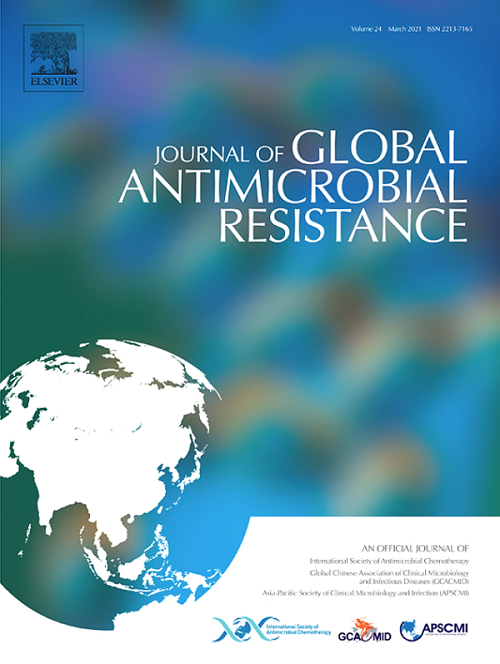静脉与静脉联合鞘内/脑室注射多粘菌素B治疗鲍曼不动杆菌颅内感染的疗效比较:回顾性研究。
IF 3.2
3区 医学
Q2 INFECTIOUS DISEASES
引用次数: 0
摘要
简介:鲍曼不动杆菌(鲍曼不动杆菌)引起的颅内感染是常见且危及生命的。本研究旨在比较静脉注射(IV)多粘菌素B与静脉注射(IV)联合鞘内(IVT)/脑内(ITH)多粘菌素B治疗此类颅内感染的临床疗效和与30天死亡率相关的危险因素。方法:回顾性分析2018年11月至2023年3月收治的鲍曼不动杆菌颅内感染患者。根据建立的纳入和排除标准,57例患者被纳入研究。静脉多粘菌素B联合IVT/ITH多粘菌素B治疗的患者分为静脉+ IVT/ITH组,单纯静脉多粘菌素B治疗的患者分为静脉组。系统地收集和分析基线特征和治疗结果。Kaplan-Meier生存分析和多变量logistic回归分析。结果:本研究涉及57例获得鲍曼不动杆菌颅内感染的患者。治愈率为31.6%(18/57),30天死亡率为33.3%(19/57)。与静脉注射组相比,静脉注射加IVT/ITH组的治愈率更高(15.4%比45.2%,p = 0.034),30天死亡率更低(50.0%比19.4%,p = 0.015)。多因素logistic回归分析显示,缺乏IVT/ITH多粘菌素B (p = 0.043)和入院时已存在的肾功能不全(p = 0.027)与30天死亡率增加独立相关。结论:静脉注射和静脉注射/体外注射多粘菌素B联合治疗鲍曼不动杆菌感染是一种有效的治疗策略,具有更高的治愈率,显著降低30天死亡率和显著的生存优势。值得注意的是,ITH/IVT治疗似乎不会增加神经毒性的发生率。然而,与IVT/ITH多粘菌素B相关的神经毒性的真实发生率可能被低估。本文章由计算机程序翻译,如有差异,请以英文原文为准。
Comparative efficacy of intravenous versus intravenous combined with intrathecal/intracerebral ventricle injection of polymyxin B for Acinetobacter baumannii intracranial infection: A retrospective study
Objective
Intracranial infections caused by Acinetobacter baumannii (A. baumannii) are common and life-threatening. This study aimed to compare the clinical efficacy and risk factors associated with 30-d mortality rates between intravenous (IV) polymyxin B and a combination of intravenous (IV) with intrathecal (IVT)/intracerebral (ITH) polymyxin B in the treatment of this type of intracranial infection.
Methods
This retrospective study analysed patients with A. baumannii intracranial infections treated from November 2018 to March 2023. Based on the established inclusion and exclusion criteria, 57 patients were included in the study. Patients treated with IV polymyxin B combined with IVT/ITH polymyxin B were assigned to the IV plus IVT/ITH group, while those treated solely with IV polymyxin B were assigned to the IV group. Baseline characteristics and treatment outcomes were systematically collected and analysed. Kaplan-Meier survival analysis and multivariate logistic regression analysis were performed.
Results
The study involved 57 patients who acquired A. baumannii intracranial infection. The cure rate was 31.6% (18/57) and a 30-d mortality rate of 33.3% (19/57). Compared to the IV group, the IV plus IVT/ITH group demonstrated a higher cure rate (15.4% vs. 45.2%, P = 0.034) and lower 30-d mortality (50.0% vs. 19.4%, P = 0.015). Multivariate logistic regression analysis indicated that the absence of IVT/ITH polymyxin B (P = 0.043) and the preexisting renal insufficiency at admission (P = 0.027) were independently associated with increased 30-d mortality.
Conclusions
The combination of IV and IVT/ITH polymyxin B administration represents an effective therapeutic strategy for A. baumannii infections, demonstrating higher cure rates, significantly reduced 30-d mortality, and a substantial survival advantage. Notably, ITH/IVT treatment does not appear to increase the incidence of neurotoxicity. However, the true incidence of neurotoxicity associated with IVT/ITH polymyxin B may be underestimated.
求助全文
通过发布文献求助,成功后即可免费获取论文全文。
去求助
来源期刊

Journal of global antimicrobial resistance
INFECTIOUS DISEASES-PHARMACOLOGY & PHARMACY
CiteScore
8.70
自引率
2.20%
发文量
285
审稿时长
34 weeks
期刊介绍:
The Journal of Global Antimicrobial Resistance (JGAR) is a quarterly online journal run by an international Editorial Board that focuses on the global spread of antibiotic-resistant microbes.
JGAR is a dedicated journal for all professionals working in research, health care, the environment and animal infection control, aiming to track the resistance threat worldwide and provides a single voice devoted to antimicrobial resistance (AMR).
Featuring peer-reviewed and up to date research articles, reviews, short notes and hot topics JGAR covers the key topics related to antibacterial, antiviral, antifungal and antiparasitic resistance.
 求助内容:
求助内容: 应助结果提醒方式:
应助结果提醒方式:


